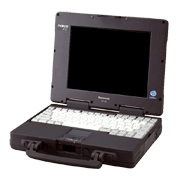Panasonic finalized the development of the CF-25 in September 1996. In Japan at the time, notebooks were still largely thought of as being expensive office computers, but in the West, where there was aggressive and strategic IT investment in field work outside of office environments, there was a strong need for ruggedness over everything else in computers that could be used in outdoor conditions. Because ordinary personal computers broke down frequently and required expensive repairs, Panasonic set out to build a rugged, "unbreakable" personal computer that would work like a "tool" in the field. After months of repeated drop tests and vibration tests, Panasonic completed the CF-25, its first "Toughbook" personal computer, which was rugged enough to clear even military standards. Used by many state police departments in the U.S., the CF-25 became famous overseas as the "Toughbook". In Japan, it was initially announced with the name "ProNote FG".
The CF-25 Toughbook's primary features were as follows.
- (1)Designed to withstand harsh environments with impact resistance, vibration resistance, and dust and moisture resistance, the CF-25 cleared military standards, including drop tests from 80 centimeters.
- (2)Designed to withstand harsh environments with impact resistance, vibration resistance, and dust and moisture resistance, the CF-25 cleared military standards, including drop tests from 80 centimeters.
Panasonic announced the CF-27 model, which featured an anti-reflection touch panel, in 1998. Over time, the product line expanded to include a size-smaller compact model, a semi-rugged model for office use (which arose from overseas specifications), and a Japan-only model with a built-in printer.


